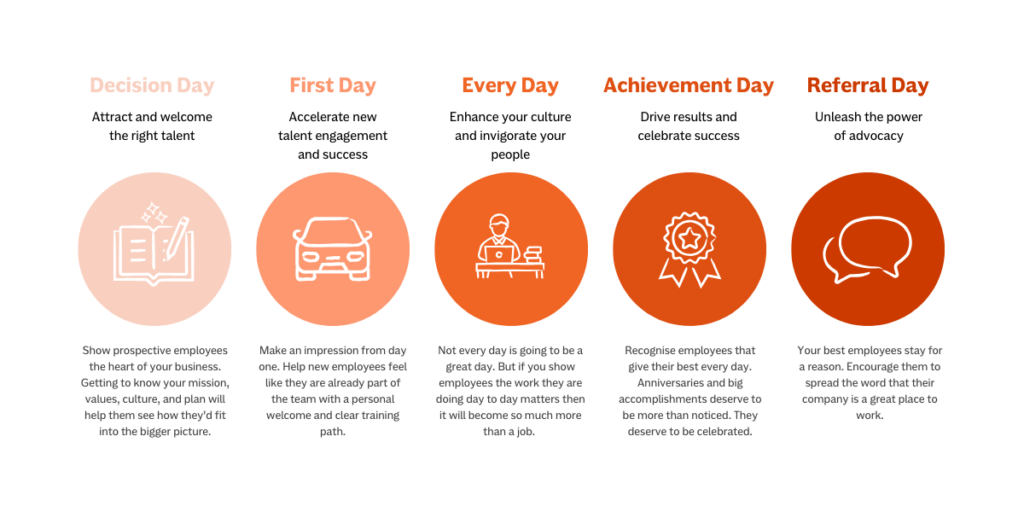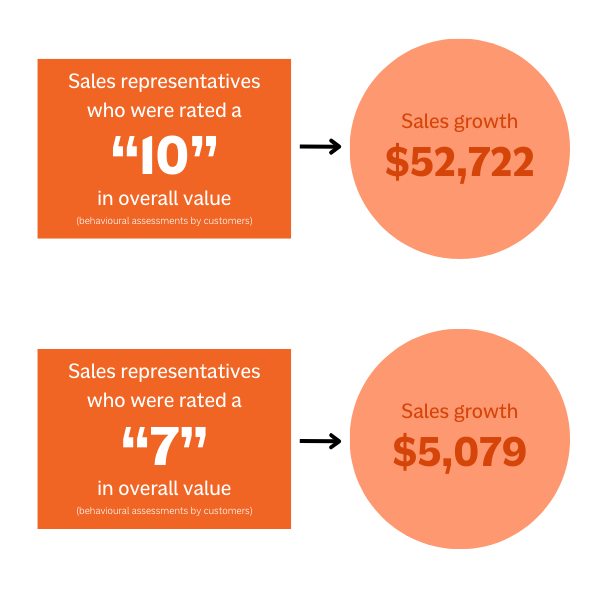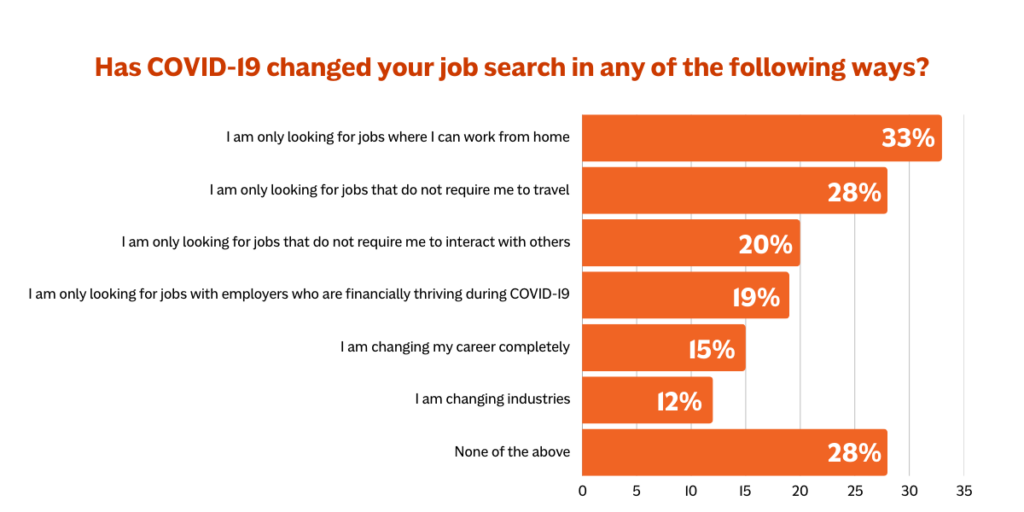Over the last year, BI WORLDWIDE has gained insights into the moves organisations can make to attract, recruit, select and retain the talented employees who help us move our business forward. These moves are designed to set a clear course about enhancing our brand by attracting and retaining employees who can help us grow.
In our approach to employee engagement, we refer to this as decision day – the moment in time when your prospective employees ask themselves, “Can I see myself here?”. This question is a critical step in the employee engagement lifecycle and the way your employees respond on decision day will have a significant impact on your employee turnover rate and satisfaction rate overall.
Before we dive into the strategies you can implement to influence an employee’s decision, we will first look how what decision day in the workplace means.
What is a decision day in the workplace?
‘Decision day’ is a term coined by BI WORLDWIDE to describe the moment when a prospective employee first starts to consider your company as an employer. This pivotal moment can greatly influence their decision to stay or leave your organisation.
These feelings and questions will stay with employees throughout their time with your organisation. They may wonder if this is where they want to be, questioning if they feel valued and appreciated, and if they are happy.

As an employer, there are certain strategic steps that you can take to ensure your organisation aligns with their values and meets expectations so they feel suited for the role, influencing their decision to stay with your company.
Below, we have provided you with ten actionable steps to make sure your recruitment and hiring practices are aligned with and supportive of recent changes in the marketplace and your organisation.
1. Realign skills, values and competencies
Many jobs that were once essential have now become obsolete due to technological advancements. Similarly, roles within your organisation may evolve which often requires a re-evaluation of the skills, competencies and values that are necessary for your organisation.
One company we know re-evaluated its sales organisation in response to new product offerings, a different competitive set, and changes in buyer habits and expectations.
Working with the client, we conducted a study analysing feedback about their sales representatives from their customers. Our research indicated a new set of competencies had emerged that predicted sales better than a competency model created several years ago:

Another client we worked with discovered a significant number of potential employees preferred working fewer hours, opting for a 25-30 hour work week instead of the traditional 40 hours. The results of such analyses may reveal the need to explore different areas of the job market or to better understand what prospective hires value. By adapting role expectations to these preferences, the company was able to expand its applicant pool and enhance its ability to meet customer demands.
Here’s an example of the development of personas, in this case for a STEM role, that can guide the design of more effective recruitment communications:

Insights like these can help an organisation determine the qualities and values they need in prospective employees. These insights can help an organisation develop a business case to align hiring practices with current organisational needs and values.
To effectively align candidates values and competencies with that of your organisation, you should ask yourself:
- Has your recruiting process changed to meet these new realities?
- Are you using the same competency model for a job, even though the job has changed?
- Are you still using the same sources to recruit employees, even though you may be looking for different employees?
- Are you using the same messages to attract employees even though roles have changed?
- Are you assessing employees for a set of competencies that are no longer relevant?
- Are you training and reinforcing to managers the importance of having a slate of candidates that is inclusive of all prospective employees?
Are you working to create an even more engaging and inspiring culture, which is the key to retaining employees?
2. Help applicants envision the match
Job applicants want to know that the job they are applying for fits their unique skills, interests and abilities. Employers want applicants who will end up staying and performing at a high level so there is mutual interest in making sure there is a good match.
In a recent study we asked employees who had just taken a new job to rate the following statement: “When I was looking for jobs, I felt uniquely suited for the position I am in now”. A third of our panel who responded to this question did not agree with this statement, indicating a lack of clarity about whether they were a good match for the role.
Those employees who didn’t see how they fit were less likely to be inspired in their current role and less likely to be working hard on behalf of the organisation.
Help yourself out. Describe the job in the recruiting process in such a way that potential applicants are more likely to see how they fit.
To ensure that applicants can envision their fit with your organization, you should ask yourself:
- Are you clear about the people who can be most successful in the roles you are promoting?
- Have you gained insights from current successful incumbents – those employees you would like to have more of?
Have you identified the sources from where successful candidates tend to come?
3. Showcase the unique selling points of your workplace
Just like product marketers highlight the unique features and benefits of a product to attract customers, employers must also “sell” their workplace to prospective employees to stand out in the competitive job market.
This can be done by crafting a compelling story that resonates with potential hires whilst conveying what makes your organisation the ideal place for them to work.
We asked a group of employees who had just started with their company to rate the following statement: “When I was looking for jobs, my organisation stood out as unique from others I was considering”. Employees who agreed with this statement were more likely to be engaged, inspired and committed to that job than if they disagreed.
In the eyes of prospective employees, we must offer what they think is not only a good job and decent workplace but one that is unique. Throughout the entire pre-employment process, you will need to show your unique value proposition, from how you tell your story to a candidate gift that reflects the unique experience you offer.
To identify and showcase your organisation’s unique selling points, you should:
- Talk to some of your most passionate employees. What do they believe is unique about your organisation?
- Ask the same question to some of your valued customers. What stands out to them about your company?
- Consult with some of your valued vendors and channel partners. What do they perceive as your unique strengths?
- Identify some organisations you believe do an outstanding job of differentiating themselves in a crowded market. They don’t have to be competitors, just companies you admire. What can you take away from their approach that would help you stand out?
4. Start employee orientation sooner
Organisations spend a lot of time and money training new employees. This training hopefully helps the new employee get up to speed quickly so they can make contributions to the organisation. We also hope new employees will be inspired to bring new ideas and creativity to their jobs.
In our research, we find employees who feel they receive the right training are twice as likely to be inspired, but employees who feel they receive training that was not useful are twice as likely to be uninspired about their work experience.
But what about companies that don’t wait for new employee orientation to help employees learn? Are those employees more inspired?
We found that new employees who learn about their job and the organisation before being hired are far more inspired and engaged than those who don’t.
There are numerous opportunities to help recruits learn about the job and organisation before joining as an employee. For example, learning could start with the job posting and continue throughout the hiring process. While your employment communications must cover essentials like salary, benefits, and job location, they should also tell a compelling story. This narrative can educate prospective employees about the job they are considering and the culture of the organisation.
Some of that learning can be targeted to specific segments of prospective employees. For example, one of our clients, a franchisor, found that many of their successful franchisees started as hourly employees. They knew that not every entry-level person would want that as a future — but some would. So they created videos of successful franchisees that could be used in their employment marketing. This helped to educate prospective employees about potential career paths they could take in the future.
To create a more engaging and effective employee orientation schedule, you should:
- Think about some of the key behaviours and outcomes new employees would value and need to be successful.
- Consider how you would weave these into your job postings and employment communications.
5. Engage and communicate with current employees and prospective employees
Recruiting a new employee is the beginning of a relationship with an employer. If a recruiter is having a bad day and is less than helpful or responsive to an applicant, the applicant will sense this. Sadly, applicants often attribute their feelings not to the recruiter but to the employer.
Through our research, we found that some recently hired employees who reflected on their recruitment experience felt that some felt their hiring managers and human resources representatives were not always friendly. Those who felt this way were found to be not as hardworking as others who had had a positive experience.
Of course, recruiters can have bad days but as employers, we must be aware that how we relate to a prospective employee can, and does, have an impact on how inspired and engaged that employee will become.
Beyond friendliness, practises such as “ghosting” applicants, where employers never get back to them, must stop. All applicants won’t become our employees but they can certainly be customers or future suppliers or individuals who will share their experiences in ways that can hurt our reputation.
Even though technology plays a significant role in recruitment and hiring efforts today, friendly and professional human interaction remains essential.
To improve engagement and communication with prospective employees, you should:
- Consider conducting a survey amongst job applicants regarding their experiences with your organisation. Reflect on responses for friendliness and responsiveness and evaluate where improvements need to be made.
- Evaluate the performance of all recruiters and hiring managers with a focus on how they treat job applicants.
6. Source more candidates to keep more hires
In speaking with hiring managers and HR professionals as to why this happens, a couple of ideas emerged. First, hiring managers who have more candidates to choose from may feel more “ownership” for the candidate they hire, leading them to want to invest more in their success. Secondly, having a choice of candidates is important in developing a committed team.
This puts even more emphasis on increasing our sources of candidates, those who are actively looking and those so-called “passive candidates” who might not be currently looking but if presented with the opportunity, would be very interested in our offer.
To broaden your talent pool and improve hiring outcomes, you should:
- Consider new sources of potential talent.
- Ensure your messaging is inspiring the right candidates to apply.
- Lean on your current employees for high-quality employee referrals.
- Address whether your recruitment communications are portraying the vision, values and unique selling points of your organisation.
7. Examine the bias in your hiring practices
Many organisations are putting additional emphasis on making sure their candidate pool reflects the diversity of the communities in which they work and live.
One CEO was quoted as saying “My current sales and service organization does not reflect the demographics of our customers. I consider that an existential problem”. It’s not only the right thing to do but this CEO is correct in that having a more diverse workforce will have a positive impact on their customer experience.
Dr. Johné Battle of Dollar General recommends asking: “Who are we excluding right now?” The answer to this question may help us determine how we will broaden our hiring process to include new sources of candidates who can contribute to our organisation.
To do this, organisations must evaluate every part of our recruitment and hiring process to identify any areas of implicit bias. If questions are asked in the pre-employment process that are biased against certain parts of our community, they need to be addressed.
But it doesn’t stop there. Once hired, we need to do even better to create an inspiring, engaging workplace where everyone feels like they belong. According to our research, the cultural factors that most predict a sense of belonging are when employees:
- Believe their jobs matter
- Don’t feel isolated
- Are recognised when they do good work
- Are confident they can fulfil their potential and grow with the organisation
- Trust leadership
- Feel supported when they make mistakes
- Have managers that make decisions in the employee’s best interest
- Have their ideas taken seriously
- Feel the organisation is open to different points of view
A useful planning exercise is the “start, stop, continue” method. Focus this exercise on creating a more diverse and inclusive workplace – what will you stop, start and continue?
To effectively examine the bias in your hiring practices, you should:
- Consider who are you excluding and build your plan from there.
- Conduct a review of your entire pre-employment process to identify and remedy all practices for which there may be bias.
8. Treat everyone on your payroll as a recruiter
One CEO of an organisation that is frequently listed as a “best place to work” once stated “We have 10,000 employees. It is my goal that every one of our employees will be a great advocate for our company and refer others to work here.”
Research supports the idea that leveraging current employees as recruiters can be highly beneficial. The cost to hire referred employees is significantly lower, and numerous studies have shown that, on average, referred employees stay longer in their roles. Our own research further supports this focus on employee referrals: employees who were referred are often far more engaged than those who were not:
| Referred to their current organisation | Not referred to their current organisation |
|---|---|
| 27% very engaged | 21% very engaged |
| 40% committed | 37% committed |
| 39% performing | 31% performing |
| 40% happy | 33% happy |
Consider if there are there positions or regions where recruiting is more challenging and, if so, are you investing appropriately to recognise those referrals? Can you really get your employees to be recruiters?
One financial services company we work with has had an active referral programme for their sales organisation. At last count, over half of their current sales representatives were referred. As with many organisations, they provide a recognition programme for employees who refer sales representatives who are still with them six months later. If employees stay, the referrer will receive points in their recognition programme account.
Companies that inspire current employees to refer candidates for open positions realise many positive benefits including higher employee engagement and lower recruitment costs.
To improve hire engagement and retention, you should:
- Consider implementing or enhancing referral programs to incentivise employees to participate in the hiring process.
- Address whether you have a system in place to recognise and reward employees who refer new hires.
- Communicate the value and success of referral programs to your workforce, highlighting how referrals contribute to the organisation’s growth and success.
9. Appeal to the changing values of job seekers
A leader of a growing company determined it was in the best interest of his business in the attraction and retention of employees that he raise their wages. In doing so, his company was able to build a loyal workforce and surged ahead in a fiercely competitive market. That leader was Henry Ford when he established a daily wage of five dollars in 1914.
This story is one of many over the years, where leaders presented a new value proposition to the job market to effectively attract and retain the employees required to achieve their mission.
More recently, the pandemic has again changed the way we look at so many things, including how job seekers value a prospective employer. According to our research, several factors related to commute time, working from home and travel are now more important than before the pandemic:

Addressing these emerging trends may also require changing who the company would want to recruit and how they would communicate in a way that attracts prospective employees whose interests and goals are aligned with our value proposition.
Therefore, employers need to understand how they can appeal to job seekers who have very different views about what is important to them in their work experience.
These examples show that employers have to amend the work experience that previously attracted and retained employees. Employers who begin to account for these changes now will be in an even better position to attract and retain a workforce that helps them achieve their goals while offering a work experience that meets the emerging values of job seekers.
To appeal to the changing values of job seekers, you should:
- Reflect on what have you learnt from these changing times and how they may impact how you scope the roles and responsibilities for a job.
- Reflect on any “mindsets” you had about a job that were relevant a few years ago but are now getting in the way of you re-imagining that job.
Have an open mind on some positive things that could come from this re-imagining. For example, might you be able to tap into other candidate sources that you couldn’t previously?
10. Create and foster an inspiring workplace culture
To be competitive, we must develop even more engaging, inspiring places to work, where new employees want to work and will thrive.
For the last ten years, we’ve been studying the elements that make for that kind of environment and have identified the twelve factors that predict greater employee commitment, effort and inspiration. We call this model the New Rules of Engagement®.
This model is key in building an inspiring workplace culture which takes the rules and makes them live meaningfully throughout your workplace. The New Rules of Engagement® are designed to make your new hires feel welcomed, appreciated, valued and included.
To create and foster an inspiring workplace culture, you should:
- Review the New Rules of Engagement model – what are the two or three factors you believe are important to your organisation?
- Take a look at our Employee Experience Snapshot tool to find out how your organisation scores against the news rules and where you should prioritise your efforts.
- Identify ways you can improve how employees feel about these rules.
Attract, recruit and retain employees to help your organisation grow
Creating a strong strategy for Decision Day is crucial when it comes to attracting and retaining prospective employees. You must establish a solid foundation that ensures they feel valued and appreciated from the moment they consider your company as an employer. This includes recognising their achievements, fostering a positive work culture, and ultimately turning them into advocates for your organisation.
By following these steps in our article and our New Rules of Engagement®, you can secure the right talent and retain the right employees who will help your organisation grow.
Ready to enhance your recruitment strategy?
At BI WORLDWIDE, we study employees to understand what motivates them, what engages them and what earns their trust and loyalty. Our comprehensive employee recognition programmes and global reward marketplace are just some of the ways you can celebrate and reward your employees’ achievements to foster a culture of appreciation and continuous engagement.
Learn more about our innovative employee engagement solutions
Discover how we can help you recruit and retain your best talent to build a thriving workplace.
